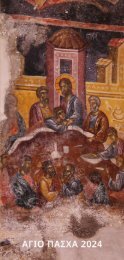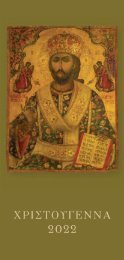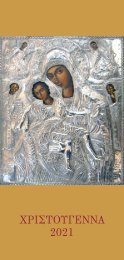You also want an ePaper? Increase the reach of your titles
YUMPU automatically turns print PDFs into web optimized ePapers that Google loves.
48<br />
The monastery, which celebrates on the Dormition of the Theotokos, is located on<br />
the north side of Mount Stavros, a steep elevation west of the archaeological area<br />
of Gournies. Its foundation date is unknown even though non-extant sources mention it<br />
already at the end of the 13th century, connecting it with the revolution of the Kallergi<br />
against the Venetians in 1299.<br />
The monastery is structured incrementally on two main levels.<br />
On the lower level, around an elongated courtyard with entrance<br />
from the west, are relatively simple two-and three-storey<br />
buildings which received a radical restoration in the second half<br />
of the 19th century. The cavernous church dedicated to the Dormition of the Theotokos<br />
and the Zoodochos Pigi [the Life-giving Spring] is located on the second, highest level.<br />
The church, which is the oldest surviving part of the monastery, dates to the period of<br />
the late Venetian occupation. It consists of the narthex, the main church, roofed with a<br />
pointed vault, as well as the area of the<br />
agiasma [holy water]. Despite the<br />
interpolations received by the complex<br />
during the 20th century, its fortified and<br />
defensive character, which was structured<br />
in the 18th and 19th centuries, is evident<br />
not only from the solid ordering of the<br />
HOLY MONASTERY OF<br />
FANEROMENI<br />
AT IERAPETRA<br />
buildings but also from the very small windows and the three semi-circular watchtowers<br />
which are located on the north side. The monastery, built in a particularly advantageous<br />
location that offers a panoramic view of the bay of Merambellou, is one of the most<br />
important pilgrimage sites of eastern Crete with hundreds of pilgrims arriving and<br />
spending the fifteen days of the fast there prior to the celebration of the feast of the<br />
Dormition of the Theotokos on August 15.<br />
The church of St. George was the catholicon of a monastic complex, a dependency<br />
of the Monastery of the All-Holy Virgin Faneromeni [‘She who is Revealed’] to its<br />
south east and at a distance of around four kilometres. The complete absence of written<br />
sources does not allow the reconstruction of the early history of the monastery, which<br />
was already abandoned by the end of the 19th century, and its buildings had been<br />
SAINT<br />
GEORGE<br />
AT ASSARI<br />
converted into homes for the farmers of the area. The single-nave,<br />
restored, small church is dated on the basis of its wall painting decoration<br />
to the 14th century. In its iconographic programme, apart from the<br />
scenes from the Gospel cycle, of which the large representation of the<br />
Birth stands out, the scene of the Sacrifice of Abraham on the north<br />
wall of the sanctuary as well as six scenes from the cycle of St. George, are included. The<br />
representation of the Dormition of St. Ephraim the Syrian on the south part of the barrelvault<br />
is of particular interest, a theme which is repeated in Crete only in the church of St.<br />
John at Kapetaniana, on the south coasts of the province of Heraklion. 49<br />
The Dormition of St. Ephraim the Syrian.


















